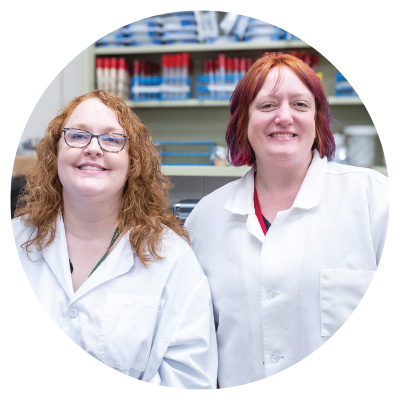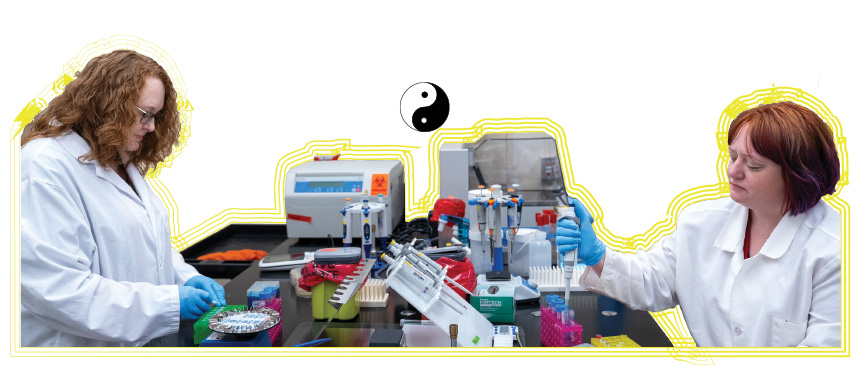

Science isn’t just about isolated discoveries in sterile labs—it’s about relationships, shared ideas, and a collective drive to solve complex problems. For Dr. Victoria Watson and Dr. Shawn Zimmerman, both DVM/PhD holders and assistant professors in the Department of Pathobiology and Diagnostic Investigation at Michigan State University’s College of Veterinary Medicine, their professional journey is a testament to how scientific progress thrives through collaboration and a supportive research environment.

Watson and Zimmerman study host-pathogen interactions and the gut microbiome, with a focus on Escherichia coli (E. coli). While many E. coli strains are harmless or even beneficial, some are pathogenic and can cause serious illness in vulnerable populations such as young children, immunocompromised individuals, and neonatal animals.
Though they share common research interests, Watson and Zimmerman approach their research from different perspectives. Watson primarily studies the gut-pathogen relationship from the host’s point of view, while Zimmerman typically examines it from the pathogen’s side. This complementary approach allows them to uncover deeper insights into how E. coli pathogens interact with the host. Both researchers are interested in not only exploring how the microbiome influences disease susceptibility but also if knowledge about microbiome dynamics can be exploited to develop custom microbiome-based treatments—essentially personalized medicine for pathogens.
One intriguing aspect of their research is the connection between the gut microbiome and chronic health conditions like obesity, inflammatory bowel disease (IBD), and diabetes. In human medicine, these interactions are an active area of study. However, the extent to which these findings apply to companion animals (dogs, cats, horses) remains unknown. To address this gap in knowledge, Watson and Zimmerman are curating samples for archives (blood, serum, feces, urine, and tissue) collected from healthy non-obese animals, healthy obese animals, and both non-obese and obese sick animals (e.g. IBD, diabetes, and other chronic illnesses). By studying the microbiome patterns in these samples, the team hopes to determine whether the findings observed in human medicine hold true for veterinary species. This study could provide insights into the microbiome’s role in chronic diseases and influence treatment strategies for both animals and humans. The team also hopes this clinical veterinary sample archive can benefit other researchers engaged in veterinary research and One Health.
A defining strength of research at MSU is its robust diagnostic and archival capabilities, particularly through the Veterinary Diagnostic Laboratory. MSU has one of the busiest diagnostic labs in the country, providing access to an unparalleled volume of data and expertise that supports groundbreaking discoveries.
Watson emphasizes the importance of maintaining meticulously archived bacterial samples. “The bacteriology lab team doesn’t just store samples; they actively identify new patterns and make connections that might otherwise be overlooked.” This level of data organization is crucial. By archiving bacterial samples and sequencing pathogens, researchers can trace patterns, predict outbreaks, and develop targeted treatments.
“Next-generation sequencing (NGS) has revolutionized pathogen research,” Zimmerman explains. “It was revolutionary when we moved beyond bacterial cultures to molecular methods like PCR. Now, NGS is changing the game in human and veterinary diagnostics.”

Scientific breakthroughs rarely happen in isolation. At MSU, proximity to experts in various fields fosters organic exchanges that spark new ideas. “At MSU, I walk down the hall and chat with colleagues and meet people who can help me see my research from a new perspective,” says Watson, adding that working alongside a diverse group of experts enhances problem-solving and innovation.
“At MSU, I walk down the hall and chat with colleagues and meet people who can help me see my research from a new perspective,” says Watson, adding that working alongside a diverse group of experts enhances problem-solving and innovation.
Their shared interest in host-pathogen interactions is a perfect example of how two perspectives—one focusing on the host’s response, the other on the pathogen’s response—can come together to create a more complete understanding of infectious diseases.
“It really is a yin and yang,” Zimmerman says. “The host’s defenses shape bacterial evolution, and in turn, bacterial infections shape host responses.”

Ultimately, science is a team effort, and their story is a powerful reminder that the most impactful discoveries often begin with a simple conversation—and a willingness to work together toward a common goal.
“The best research environments recognize the value of different perspectives and a One Health approach,” Zimmerman notes. “It’s not just about diversity in background but also diversity in training and thought—being able to see across various science disciplines and connect the dots in ways that wouldn’t be possible alone.”
